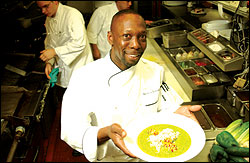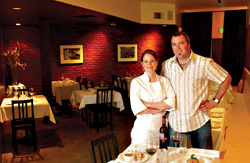More than 50 years ago, Alice B. Toklas presented a surprising portrait of gazpacho in her Alice B. Toklas Cook Book. The recipes she gathered during her travels in Spain are unorthodox, at least when compared to what’s widely recognized as the basic modern formula: garlic, olive oil, bread, tomatoes, cucumbers, and water. Toklas’ variant from Málaga contains veal broth, her Cordoban version calls for heavy cream, and her Segovian recipe includes cumin, Spanish onion, fresh basil, and red bell pepper. Any of these would have been a tall order for the Iberian peasants who supposedly invented the dish; their version consisted of bread, garlic, olive oil, and water mashed up in a mortar. Following Columbus’ journey to the New World, tomatoes became a core ingredient as well. Today, gazpacho has been reinterpreted so extensively that authenticity has ceased to be a pressing concern, even to connoisseurs of the dish.
This notion is borne out in the divergent ways Seattle chefs reinvent the dish each summer. Tango‘s Michael Bruno, who will lead a gazpacho-making demonstration at Pike Place Market on Sunday, Sept. 11, makes one of the city’s most satisfying versions ($4), using heirloom tomatoes, sherry vinegar, sweet Japanese bread crumbs, garlic, lots of olive oil, and fresh melon—either cantaloupe or honeydew, “depending on the color of the tomato,” he says. While using melon to add sweetness is a tradition associated with Málaga, Bruno finds that it makes the soup’s texture smoother, too. He’s also used pear and apple ciders as sweeteners.
For his menu at Andaluca, executive chef Wayne Johnson has crafted a sophisticated variation on green gazpacho ($4.50), a specialty of the southwestern Spanish province of Huelva. Johnson uses a cucumber base, to which he adds romaine lettuce and celery, plus garlic, sherry vinegar, cilantro, a few other herbs, and potato bread from Belltown’s Macrina Bakery. He tops the soup with a bit of Dungeness crab, whose sweetness “just works so well with the zing of the sherry vinegar,” he says. At Andaluca, gazpacho is served between 50 and 60 degrees, about five degrees warmer than the usual temperature range. Johnson feels that too much chill mutes the soup’s subtle flavors; when he offers red gazpacho as a special, a moderate temperature becomes even more important, since the tomatoes he chooses are usually heirlooms, which are famously complex in flavor. What variety of heirloom is best for gazpacho? Brandywines “really [add] a nice color, and they’re plump and they give it a little meatiness,” he says.
Johnson also uses a salsalike variation on gazpacho as a sauce for his menu’s crab tower, a use that Harvest Vine chef-owner Joseph Jiménez de Jiménez says is common in his native Basque Country. According to Jiménez, a gazpacho paste is employed in Basque kitchens to top lobster, monkfish, or roasted beets. He says that every city in Andalusia has its own take on gazpacho; even in its regional home, there’s no “right” way to make it. In that spirit, Jiménez experiments freely when making the Harvest Vine’s version ($3). Sometimes he substitutes lobster stock for water; sometimes he adds watermelon. One near-constant feature of Jiménez’s gazpacho is Spain’s exceptional almazara, a type of olive oil gathered before the actual pressing of the olives.
What to do when the gazpacho craving hits and a sit-down dinner isn’t possible? The Spanish Table and Pike Place Market’s Michou both serve the soup to go. According to manager Victor Couto, the Table’s ($4.49) is made with Roma tomatoes, seven-year-old sherry, French baguette bread, and spicy, fruity olive oil. Michou owner Michkat Chatti says her version ($3) includes canned diced tomatoes, red onions, English cucumbers, cilantro, and a touch of Tabasco.
If you make gazpacho at home, remember that the key to perfecting its flavor is trial and error. See how different oils and vinegars interact with different tomatoes, use various types of bread, and toss in a few herbs here and there. But until you’ve mastered the basics, stay away from the heavy cream.
Tango, 1100 Pike St., 206-583-0382; Andaluca, 407 Olive Way, 206-382-6999; Harvest Vine, 2701 E. Madison St., 206-320-9771; Spanish Table, 1427 Western Ave., 206-682-2827; Michou, 1904 Pike Place, 206-448-4758.








